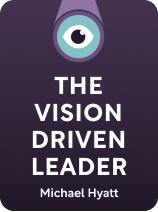

This article is an excerpt from the Shortform book guide to "The Vision Driven Leader" by Michael Hyatt. Shortform has the world's best summaries and analyses of books you should be reading.
Like this article? Sign up for a free trial here.
What makes some leaders and their teams consistently outperform others? Why do certain organizations maintain focus and momentum while others get distracted by every new opportunity?
The benefits of a vision extend far beyond mere goal-setting. A well-crafted vision serves as both a powerful motivator and a strategic compass, helping organizations navigate challenges and make better decisions about their future.
Keep reading to explore Michael Hyatt’s insights into how a compelling vision can transform your leadership approach and revolutionize your organization’s performance.
The Benefits of a Vision
It takes some work and discomfort to become a vision-driven leader—so why should leaders do so? According to Hyatt, setting a vision for your organization is important because a vision motivates people to work hard, even in the face of obstacles, and it improves your strategic decisions. Let’s explore these two benefits of a vision.
Benefit 1: A Vision Is Motivational
Hyatt explains that your vision can inspire you and your team to work hard as you try to fulfill it. regardless of the obstacles in your way. It does this in a number of ways:
- Most people want to face challenges that require creativity and novel thinking—your vision provides a direction for that creativity, sparks imagination, and challenges their skills.
- It connects individuals’ tasks to the larger goals of the company, so their work feels meaningful and they’re more willing to do their best.
- Without a vision, neither employees nor managers and executives know what to focus on. A lack of focus makes them more likely to waste time and effort, feel as if their work doesn’t matter, and quit out of frustration.
| The Psychological Impact of a Motivational Vision There are several psychological phenomena that help explain the motivational power of a good vision. Self-determination theory, a prominent framework in motivational psychology, posits that intrinsic motivation is driven by three key factors: autonomy, competence, and relatedness. A well-crafted vision can address all three: Autonomy: Employees feel driven by a sense of purpose, pursuing something they genuinely want—rather than feeling compelled to work toward. Competence: Employees are challenged to develop new skills. Relatedness: The vision connects employees’ work to larger organizational goals. Furthermore, the state of engagement Hyatt describes, in which employees are creatively challenged and deeply focused on meaningful work, closely resembles the psychological concept of “flow.” This optimal state of experience, characterized by complete, enjoyable absorption in a task, typically occurs when individuals engage in activities that are both challenging and meaningful—precisely the conditions that a compelling vision can create. |
Benefit 2: A Vision Leads to Improved Strategic Decisions
Another benefit of a vision is that it improves your strategic decisions, explains Hyatt. It does so in two ways: First, it helps you identify opportunities for growth and development by keeping you focused on the future. If you’re always looking for ways to better fulfill your vision, you’re more likely to recognize these opportunities. This contrasts with people who focus so much on what’s working for the company now that they fail to innovate, and they become obsolete.
Second, once you’ve recognized an opportunity for innovation, you can ask yourself whether pursuing it would help you achieve your vision. If not, you can turn down that opportunity and avoid wasting resources on distractions to your vision, even if they’re lucrative.
For example, imagine your company manufactures medical equipment for hospitals. You develop a vision for your company: Become a leading manufacturer for not only hospitals, but also doctors’ offices, nursing homes, rehabilitation centers, and home use. One branch of your company makes a slight profit by providing delivery services for the equipment as well. However, this doesn’t serve your vision for the company but instead distracts from it—expanding this practice requires more employee training and time spent coordinating delivery times with customers. Instead of investing more resources into this distraction, you partner with a third-party delivery service so you can focus your company’s efforts on achieving your vision.
| Maintaining Adaptability in Pursuing Your Vision While a strong vision can improve strategic decisions, a relentless fixation on the vision can create organizational blind spots, causing a company to overlook important market changes that fall outside the scope of its vision. This could result in inflexibility and a lack of adaptability, which are particularly damaging in unstable or frequently changing industries. Experts note that rapidly advancing technology, increased transparency, and the global spread of industries has destabilized many business environments. Because of this, companies that fail to notice and quickly respond to even relatively minor changes in the industry—such as new competitors, shifts in consumer demand, or the obsoletion of certain technologies—can fall behind and even fail entirely. To avoid this pitfall, keep an eye on market trends, consider alternative solutions for every problem you face, and reflect on changes you can make to your vision to accommodate these solutions. |

———End of Preview———
Like what you just read? Read the rest of the world's best book summary and analysis of Michael Hyatt's "The Vision Driven Leader" at Shortform.
Here's what you'll find in our full The Vision Driven Leader summary:
- How to turn a failing organization into a thriving success
- The benefits of having a strong vision as a business leader
- How to sell your vision to your team, superiors, and peers






